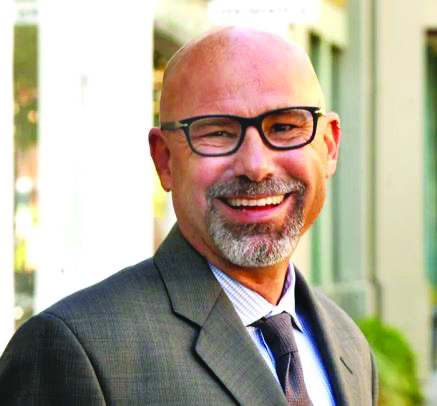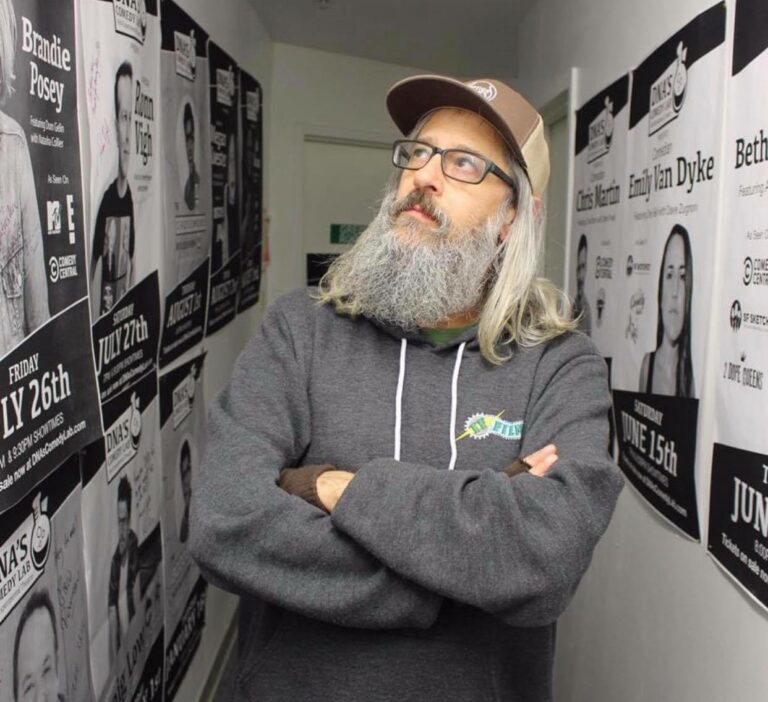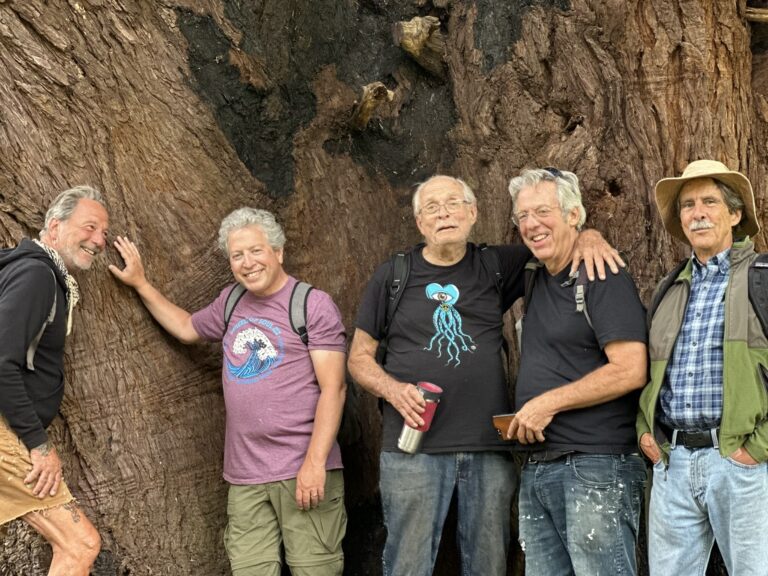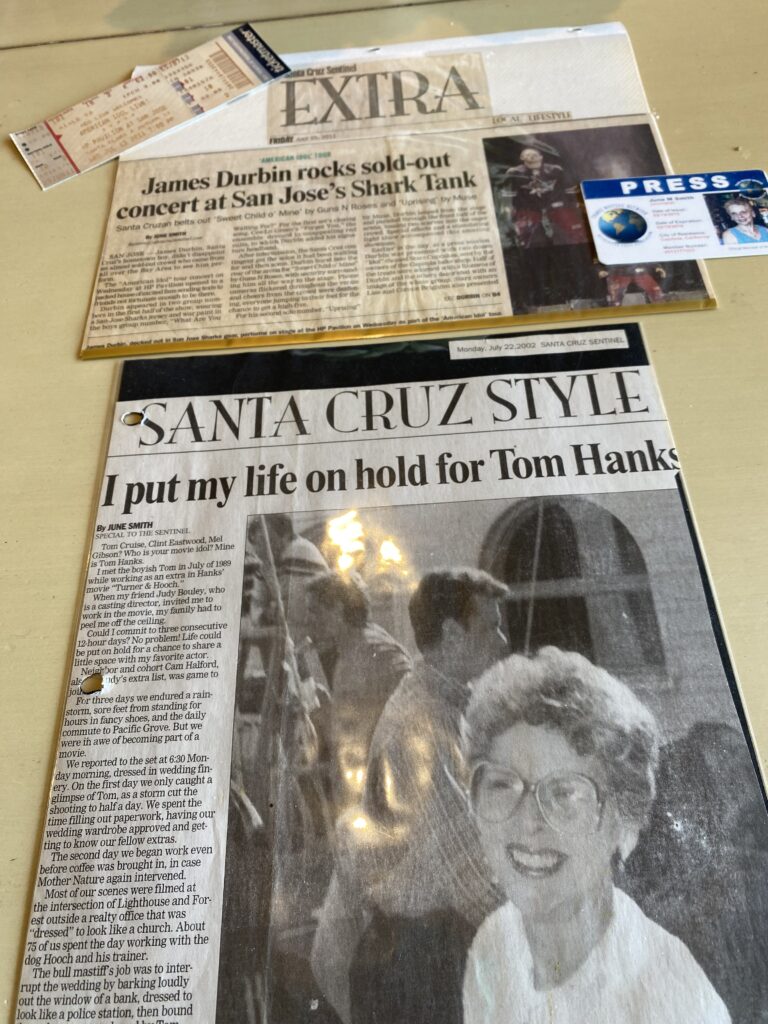Performing comedy in the 21st Century all while aging like a ripe melon.
My name is DNA and I’ve performed stand-up comedy in Santa Cruz and beyond since 2005. I’m 61. Even when I started out, I was twice as old as everyone else. At this point, I’m wrestling with early rigor mortis every time I get onstage.
I once had a Maverick surfer tell me, after seeing me do a set of comedy at The Blue Lagoon that, “he could never do what I do.” I didn’t understand how a person who surfs 50-foot-waves would think that standing onstage at a dive bar and telling wiener jokes into a microphone was scarier than the possibility of ending up in the boneyard. But, you often hear that public speaking is a top fear of people. For me, making strangers laugh is my superpower. Offstage I can barely hold a conversation, but onstage, I’m a chatterbox.
It wasn’t always the case. I’m highly neurodivergent. It’s not something I often, or ever, talk about. I didn’t even have a word for it until a few years ago. I recently got diagnosed with ADHD. But apparently what I have is an Audio Processing Disorder. My hearing is just fine (what wasn’t obliterated by decades of live music events) but my brain has trouble processing information. For instance, if I’m in a place with a lot of ambient noise (i.e everywhere) I might have trouble understanding what you are saying. Also, I find it very difficult (even after decades of building coping mechanisms) to talk to more than one person at a time. But, having a framework to understand why I am the way I am, has been the source of great relief.
And, I think that’s one of the secrets of us Over-50s: that life will continually surprise you. There’s always room for constant growth. This is true even if nobody else recognizes that you’re still growing.
If you’re over 50, congratulations. You made it through a half a century. You probably haven’t gotten a conciliatory pat on the back recently, but consider it an accomplishment. I’m proud of you. You think I’m joking, but this one time, I’m not. It’s OK to age. What is all this stigma around aging? I understand that youth culture exploded after World War II, but how did we get to a point where children are influencers on TikTok and make more in one month than I make in a year?
I have a theory that when I was growing up, whenever I had a question, I had to go to my dad or older brothers. “How do you change a tire on a car?” “What’s this bump on my scrotum?” “Who should I vote for?” But then in the 1990s, with the rise of the internet, older people got sidelined for being a source of knowledge. The elders became Ask Jeeves and Dogpile. And I think, culturally, we’ve never come to grips with wisdom being outsourced to iPhones. Plus, us “oldies” have to deal with people we know dying all the time.
My parents read the obituaries every morning. That was their routine. “Look, Henry from down the street died,” my Mom would say. “I knew that. Everyone knows that,” Dad would say, somehow trying to out-game my Mom. I never wanted to become that, but as I’ve gotten older, it isn’t uncommon to hear about somebody dying. I never know what I’m supposed to do with that information. Somedays I avoid Facebook because it’s become the modern-day obituaries page.
In my 50s, I was afraid to let people know how old I was, as if my graying hair and beard weren’t giveaways. Maybe I thought I could fool people into believing I was still young so they could relate to me. But, something liberating happened when I hit 60, I just didn’t care anymore. I feel empowered for having made it this far. I’ll put it out there. I’m glad I got to live through the decades I lived through.
Younger people have to constantly worry about their online presence and image. I’ve never worried about it, even before social media, my image wasn’t something I was concerned about. I didn’t grow dreads in the 1980s because I wanted to look cool, I just hated brushing my hair.
I don’t know if I saw it on a Brady Bunch episode, or where I got the idea initially, but I started putting on shows in the basement of my parent’s home. I enlisted my more-than-willing younger nephews, who were living with us, and presented an evening or afternoon of magic, comedy and ventriloquism.
My sister, who has gone on to be a distinguished teacher and writer in the field of child psychology, could spot a trend. Soon, she was my manager. I was 9 years old and out doing magic shows for nursing homes, nursery schools, birthday parties and whoever would pay me $25. (Side note: that’s more than I make now on most comedy shows).
I always loved comedy. Tough to look at fondly now, but we listened to Bill Cosby albums over and over. He was the first person to get me and my nephews rolling on the ground. I got older and got into Cheech and Chong, Richard Pryor, George Carlin, Steve Martin, and later Bill Hicks. At the same we watched Carol Burnett every week. My dad loved Mel Brooks and we saw Blazing Saddles in the theater. My family would sit around and tell jokes in Yiddish. My namesake, my great uncle, owned a hotel in the Catskills and booked a very young Sid Caesar in his first comedic performance. Comedyiis in my genes.
I love making strangers laugh. I like that I can help somebody’s brain find some comfort. I also enjoy being able to control the conversation (thanks microphone), while at the same time, being forced to interact with any chaos. Plus there’s a time limit. If I could know exactly how long each conversation I have is going to be offstage, I’d be more secure.
Almost every single person I know has kids, grandkids, retirement, vacations, own homes, new cars. I don’t have any of that. I don’t live under the illusion of “making it.” I don’t even know what that would mean for me. What I do know, is when I interact with 100 people under the age of 25 in a backyard in San Jose, and I get them laughing hard, that I’ve accomplished something that scratches an itch I have.
It seems to me, and this is strictly my opinion, that over 50 in this country is quickly becoming irrelevant. For somebody that always craved isolation, I’m still amazed how invisible I am in most situations. According to a 2023 statistic, there are roughly (give or take a percentage) the same amount of Boomers, Millennials, Gen Z and Gen X in America. I fall into Generation Jones, the lost generation.
The other night onstage I mentioned Bob Marley, and a person in the audience – if you could call it an audience – said, “I’m sorry, but I barely know who Bob Marley is.” This is what I’m up against. There’s an intergenerational cultural dissolve happening. I was born in the 60s and came of age in the 70s, but I still know about actors or songs from the 50s and earlier. Okay, maybe it’s true that I had to watch Abbott and Costello, and The Three Stooges every single day because nothing else was on. That’s true. But, we’re losing our reference points as a society.
Lately, I just want to talk about Climate Change. I know, a real knee slapper and laugh riot. I feel compelled. I think one reason is because I’m older. When I started in my 40s, I was like a lot of new comics. I went for a lot of the lowest common denominators. Genitalia jokes. Reproduction jokes. Sex jokes. A lot of shock value there. You will probably get a reaction from the audience and that seems like a win at first, but I feel compelled to try and reach higher.
I think us over-50s need to remind the youth that we’re not invisible and that we’re essential by being consistent, supportive, honest and realizing they may not want to talk about Creedence Clearwater Revival.
I asked a couple of my comedy friends some questions regarding aging and comedy. And in order to keep them my friends, I will not be disclosing their age (spoiler alert: they’re all over 50).
Do you ever experience ageism (besides all the other ‘isms’) in comedy?
Karin Babbit is a Ben Lomond resident and one of the original LA Comedy Store female comedians. Babbit is a vibrant force of nature onstage and off.
“I don’t. I think it is only because I am not listening for it, nor do I care about it. I’m way too busy listening to the laughs and trying to figure out the crowd. Sometimes I feel a little jolt when someone refers to me as a ‘Legend of The Comedy Store.’ It just seems so weird, as I was only aware of being one of many nightly workers. I don’t stand in lines for stage time, nor do I pay to play. I have paid my dues. I know what I have. If I have more hoops to jump through, I will go jump rope instead. Not interested in groveling anymore. G-d[1] knows I have done enough of that in L.A. I work out hard to improve, several times a week, with peers. My chops are back and that is my primary focus. I want to be a good comic, not a victim.”
Richard Stockton is a Santa Cruz comedian who was one of the only white comics to be featured on BET. Stockton’s Planet Cruz comedy shows continue to be a source of joy for the community.
“Ageism in comedy? Imagine that. I’m lucky on the central coast because I have an audience here, affectionately described as ‘old people and their parents.’ But clubs in San Diego, with an audience largely of thirty-somethings, have inexplicably found me funny and I work in front of people who could be my grandchildren. When I walk into the comedy club I am invisible. I’m a piece of furniture that young people are annoyed to have to walk around. Then, when they see me walking onto the stage they are shocked, and yes, there are jokes I specifically use to connect to them.
I’ve been an entertainer all my life, I’m 74 years old, but I have the resume of a man in his 20s, and I can see the 25-year-olds smile and relax. Comics at my age have to be better to work at all, but the good news is, if you keep honing your craft, keep polishing the rock, you do get better. Two words: George Carlin.”
Jackie Kashian has a half-hour special on Comedy Central and has appeared on CBS, NBC and tours internationally. Kashian has entertained the troops in Africa and the Middle East several times.
“Much like the other ism’s I don’t think about it because I’ve got to keep going forward. If there was a drone watching my career and experiences, I’m sure I could see the sexism or fat phobia and now, ageism. Because knee jerk reactions from society’s jerks… exist.”
Laurie Kilmartin, born in San Jose, is a stand up comedian and an Emmy-nominated, WGA award-winning comedy writer. She was a staff writer for all 11 years of CONAN on TBS, and has performed standup on CONAN, Late Late Show w/James Corden, and Comedy Central.
“I believe so, but nobody tells you why they don’t work with you. In the 90s/00s, there was ridiculous sexism in comedy, and now… the industry decided it likes female comics, especially if they’re young.”
Tony Camin began performing as an on-air personality at The Bay Area college radio station KFJC. In the 1990s, Camin began performing comedy at the small but highly influential San Francisco venue, the Holy City Zoo.
“Hmmm. Only once overtly. A bad weekend room in New Jersey. Had good shows, but the guy running it wouldn’t have me back because he thought I was too old, which was funny, because I was 45 at the time and this guy was 65. Told the booker he’d consider me if I dyed my hair. It was so low stakes, it was funny.”
Ngaio Bealum was the weed expert on the Netflix show, Cooking on High. Bealum tours the world performing comedy and judging weed.
“A little. But club comedy is more about asses in seats than your age. As long as you can draw a crowd, they will book you. Now, getting on TV and Netflix and stuff can be a challenge because Hollywood always wants the young demographic.”
Do you make an effort to “relate to younger people” when you perform, or does your material remain unchanged?
Karin Babbit
“As you know, I am a whack job. I represent a type. My age is just part of the joke. Young people get to laugh out of relief that they are not where I am. Right now I have worked out a new 15 minutes about age and death. A lot of death stuff. I try to talk about what is true — brutally. If it alienates you today, you might get it up the road. But I’ll be dead, so I have no way of knowing. Enjoy.”
Jackie Kashian
“My material changes because I’m not stagnant. Stagnancy doesn’t only come with age. And, I do try to write to the whole audience. So, yes I make an effort to relate to younger people. And men. And drunk people. City Mice. Country Mice.”
Laurie Kilmartin
“I remember when I was young, I hated when comedians talked about aging, it bored me. (Probably because I was young.) I am finding now that I like talking about my perspective, from this age, but I don’t want to talk about aging. I think comics should talk about what genuinely interests them, and it’s the ‘job’ to do it in a way that makes most of the audience laugh.”
Tony Camin
“I do have a lot of stuff on aging, but I don’t think it’s exclusive to an older audience. I think sometimes it’s funny to make an awkward attempt at relating only to be way off base. Mostly through crowd work. I do enjoy talking to younger audience members in particular. Recently there was a DJ in an audience and told him I knew what the kids liked… mid-era Tom Petty. So I guess, sorta?”
Ngaio Bealum
“Gotta stay current. I work with language and culture, so you gotta feel the zeitgeist and adapt. Recycle that Madonna joke into a Miley Cyrus bit. Slip in a few ‘littys’ or ‘glizzies’. My kids keep me up on the slang and I’m on Twitter too much so it isn’t a big problem. I also have jokes about getting older. Have fun and be yourself is always the motto.”






















